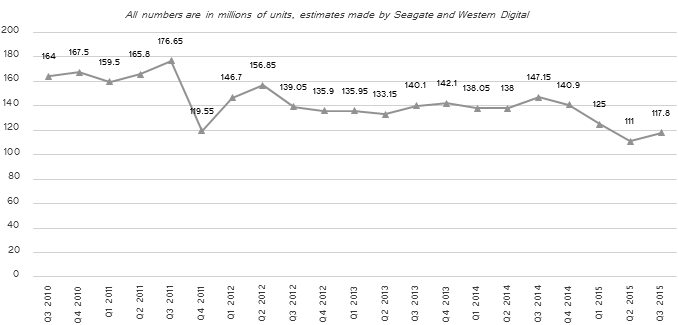Seagate: Winchesters will stay with us for another 20 years

The first hard drive in history was released by IBM back in 1956, and by the early 1980s, HDDs had become the main storage device for all types of computers. Someone says that the hard drives are out of date and it's time to replace them with much more efficient SSDs. But in reality, the "outdated" technology has not yet exhausted its potential. According to Seagate Technology, hard drives will not leave the market for another 15-20 years . To adapt to modern requirements, a number of innovative technologies will be implemented in hard drives.
Worldwide HDD sales have been declining for several years in a row. In the III quarter. 2015, the market fell to 118 million units. For comparison, in the III quarter. In 2010, 164 million hard drives were sold.

Despite this, the HDD is still the most popular storage medium for computers, as well as the cheapest, based on the price per gigabyte. In the coming years, the SSD will not be able to catch up with the HDD in this indicator, so the demand for hard drives will continue.
To maintain competitiveness, hard drives need to improve technical specifications: increase the volume and, therefore, the density of information recording. Last year, the international consortium ASTC (Advanced Storage Technology Consortium) presented its forecast for the development of the industry. According to this forecast, the HDD capacity will grow to 100 terabytes by 2025, thanks to the introduction of new technologies, as shown in the diagram.


In a couple of years, modern PMR and helium-filled SMRs will be replaced by TDMR (two dimensional magnetic recording) magnetic recording technology. At the same time, HAMR technology (heat-assisted magnetic recording technology) is not yet ready for commercial production of hard drives, Seagate reports, despite the fact that companies have repeatedly shown prototypes of HAMR hard drives. There is information that for such discs it is still not possible to achieve acceptable indicators of reliability.
“We talked about two-dimensional magnetic recording last year and we will be ready to release such hard drives in a year or two,” saidDave Mosley, president of operations and technology at Seagate, speaking at a conference for analysts and investors this September. “HAMR is not yet ready for commercial release, I’m not too pleased with the progress over the past year, but it’s still progress.”
The illustration shows the TDMR operation scheme: it further increases the density of recording information on the HDD due to the imposition of magnetic tracks on each other. That is, the tracks themselves will be smaller than the read heads, but this will not interfere with the reading, since individual bits on adjacent tracks will be offset from each other.

For example, the read head reads several adjacent tracks at once, and then the desired one is selected from them, although engineers are now working on different versions of TDMR. Maybe they decide to use several read heads at the same time.
According to Seagate, TDMR compaction will increase the recording density of information by 5-10% for starters, then even more.
The technology of thermo-assisted magnetic recording (HAMR) provides for short-term heating of the magnetic surface with a laser during data recording. In the Seagate implementation, the surface is heated to 450 ° C by a 20 mW laser with a wavelength of 810 nm.

This method allows you to significantly increase the recording density: from 1.1 Tbps per square inch on the SMR to 1.5 Tbits per square inch and, in the future, up to 2-5 Tbps per square inch. If you manage to bring technology to mind, this will be a real revolution in the HDD market.
Seagate hopes to send partners the first samples of HAMR hard drives at the end of 2016 or the beginning of 2017, and mass deliveries begin a year later. But this is under the condition that everything goes according to plan and succeeds.
In the longer term, engineers will begin to tightly refine even more advanced recording technologies that seem fantastic so far: Bit Patterned Media Recording (BPMR), Heated Dot Magnetic Recording (HDMR), Microwave-Assisted Magnetic Recording (MAMR).

These innovations will allow us to enjoy rumbling disc plates for a couple of decades, according to Seagate forecasts.
